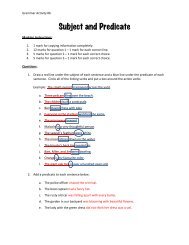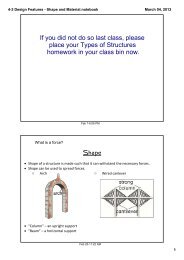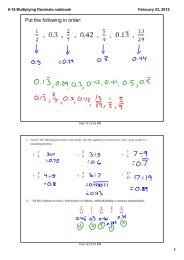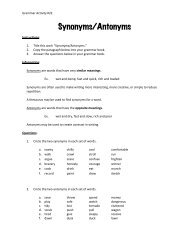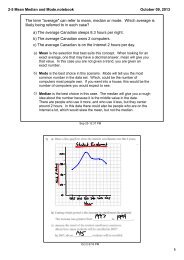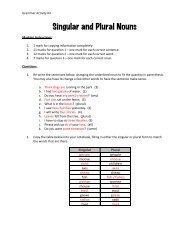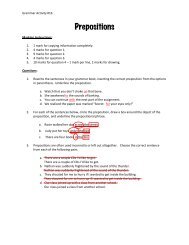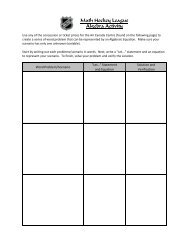Today I will be explaining your next experiment. This is a 4 day long ...
Today I will be explaining your next experiment. This is a 4 day long ...
Today I will be explaining your next experiment. This is a 4 day long ...
- No tags were found...
Create successful ePaper yourself
Turn your PDF publications into a flip-book with our unique Google optimized e-Paper software.
<strong>To<strong>day</strong></strong> I <strong>will</strong> <strong>be</strong> <strong>explaining</strong> <strong>your</strong> <strong>next</strong> <strong>experiment</strong>.<strong>Th<strong>is</strong></strong> <strong>is</strong> a 4 <strong>day</strong> <strong>long</strong> <strong>experiment</strong>, involvingmultiple activities. You <strong>will</strong> <strong>be</strong> doing <strong>your</strong> secondlab report based on th<strong>is</strong> <strong>experiment</strong>.<strong>To<strong>day</strong></strong> you <strong>will</strong> need to pay very close attention inorder to ensure you are prepared to start<strong>experiment</strong>ing <strong>next</strong> class.I <strong>will</strong> call you to the back shortly.In th<strong>is</strong> activity, you <strong>will</strong> investigate the character<strong>is</strong>tics and interactions of puresubstances and mixtures. You <strong>will</strong> also <strong>be</strong> developing <strong>your</strong> laboratory skills byusing a variety of scientific equipment.Work in groups to observe the interactions <strong>be</strong>tween various types of matter.There <strong>will</strong> <strong>be</strong> eight stations to v<strong>is</strong>it. The order you v<strong>is</strong>it the stations <strong>is</strong> notimportant. At each station, carefully observe what happens.Here are some of the materials you <strong>will</strong> use:• test tu<strong>be</strong>s to hold the various materials• a testtu<strong>be</strong> rack to hold the test tu<strong>be</strong>s upright• rub<strong>be</strong>r stoppers to seal the test tu<strong>be</strong>s• stirring rods to stir the different materials• measuring spoons to place the solid into the liquid in the test tu<strong>be</strong>
ProcedureFollow the same procedure at stations 1 to 6. At stations 7 and 8, theprocedures are slightly changed.1. Pour the liquid into a clean test tu<strong>be</strong> to a depth of three fingers(about 10 mL).2. Using a clean measuring spoon, add one scoop of the solid to theliquid in the test tu<strong>be</strong>.3. Put the stopper in the test tu<strong>be</strong>. Hold the stopper with <strong>your</strong> thumb,turn the tu<strong>be</strong> upside down, and shake it.4. Record what you observe at each station in a chart.5. Make sure you wash <strong>your</strong> test tu<strong>be</strong> and spoon <strong>be</strong>fore leaving eachstation. Place the test tu<strong>be</strong> upside down in the rack to dry.Stations1. Mix salt with room temperature water.2. Mix sugar with room temperature vinegar.3. Crush an antacid tablet into powder. Mix the powder with roomtemperature water.4. Mix pepper with room temperature water. Mix a second batch in ashallow pan, then, add one drop of d<strong>is</strong>hsoap.5. Mix flour with room temperature water.6. Mix one scoop of dry chocolate powder with cold water and one scoopof the powder with hot water.7. Prepare two test tu<strong>be</strong>s, one with cold water and one with hot water.Add some juice crystals to each test tu<strong>be</strong>. DO NOT SHAKE.8. Prepare two test tu<strong>be</strong>s, one half full with sugar, one half full with hotwater. Carefully add all the sugar to the water, stirring as you do.
<strong>Th<strong>is</strong></strong> <strong>experiment</strong> <strong>will</strong> take a total of 4 periods.1. <strong>To<strong>day</strong></strong> you <strong>will</strong> have received the explanation of the<strong>experiment</strong>s.2. Next class we <strong>will</strong> try to get through three rotations.3. The third class <strong>will</strong> also <strong>be</strong> three rotations.4. During the fourth and final period you <strong>will</strong> do <strong>your</strong> last tworotations. You <strong>will</strong> then <strong>be</strong> given time to rev<strong>is</strong>it any of thestations you need to.At the end of th<strong>is</strong> you <strong>will</strong> <strong>be</strong> assigned <strong>your</strong> second lab report for theyear. With that in mind, <strong>be</strong> sure to take detailed observations andnotes.If at any point you are unsure of how to use a piece of equipment, <strong>be</strong>sure to ask.



